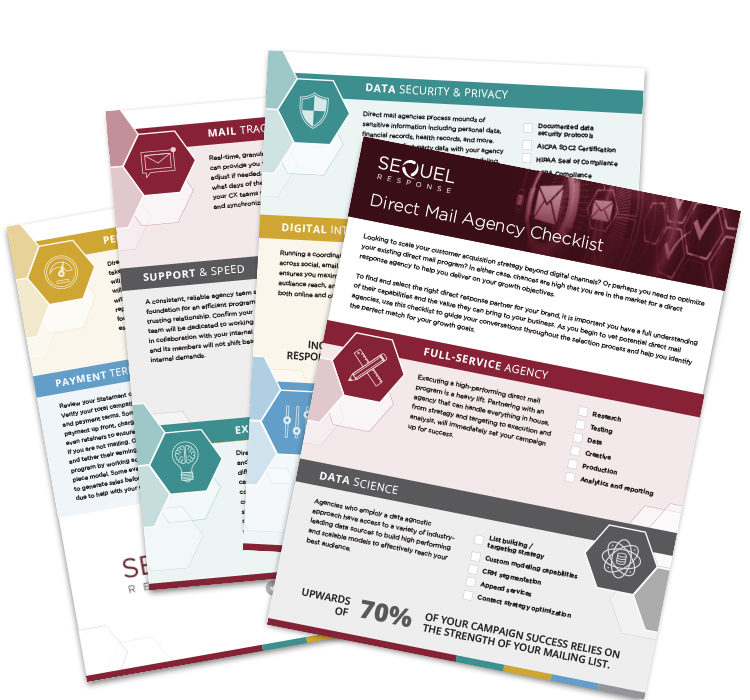Affinity Marketing vs. Customer Acquisition: How to Balance Loyalty and Growth

Even the most seasoned marketers can find each day to feel like an ongoing puzzle, with new pieces constantly being thrown their way. Yet, the picture continues to take shape when you hold on tight to trusted powerhouses like affinity marketing and customer acquisition. These two strategies are the backbone of many successful marketing plans but are far from interchangeable.
In this comparison of affinity marketing vs. customer acquisition, we will explore the strengths, purposes, and best practices of each strategy and how they work together to support your marketing goals.
|
Prefer to listen? Check out our podcast The Direct Effect: Affinity Marketing vs. Customer Acquisition |
What is Affinity Marketing?
Affinity marketing is an approach in which companies collaborate with trusted organizations, groups, or brands with commonalities. This cost-effective strategy can be understood as a mutually beneficial partnership, allowing both entities to leverage each other’s trust and credibility while providing added value to their customers. Affinity marketing is also known as:
- Partnership Marketing
- Co-Marketing
- Co-Branding
- Interest-Based Marketing
- Niche Marketing
- Aligned Marketing
- Community Marketing
- Shared-Value Marketing
Affinity data is a treasure trove of information, revealing insights into customer interests, preferences, and behaviors. Going beyond basic demographics, brands who leverage this approach gain a deeper understanding of what their customers enjoy and how they interact with the world around them.
The Role of Affinity Marketing in Customer Retention
Affinity marketing is instrumental in fostering long-term customer relationships. By aligning with like-minded organizations, you can provide tailored offerings that resonate with your target audience, enhancing customer satisfaction and loyalty. The key to successful affinity marketing lies in identifying partners whose brand values and customer demographics align with your own.

Examples of Affinity Marketing
You’ve likely seen brands use affinity marketing techniques many times before, without even realizing it. A notable example is American Express, which teamed up with Delta to offer a Delta-branded credit card. This card allows members to earn valuable benefits, including 3x miles on Delta purchases and 1x miles on all other eligible purchases. Another example is Disney, which partnered with Lyft to offer a Minnie Van Service to help families get around the Walt Disney World resort area.
Franklin Madison also specializes in affinity marketing by facilitating partnerships between banks and insurance providers. This collaboration enables banks to expand their service offerings by providing customers with easy access to insurance solutions tailored to their needs.
Success in Affinity Marketing
Here are our tips on how to make the most out of affinity marketing:
- Choose the right partner for mutual benefits: Select organizations or groups whose principles closely align with your brand and target audience.
- Provide value: Offer significant benefits or incentives to community members to foster engagement and loyalty.
- Emphasize affinity branding: Neglecting the affinity brand can diminish return on investment (ROI). Based on our 50 years of experience in affinity marketing under our parent company, Franklin Madison, we’ve discovered that promoting the affinity brand alongside its voice and standards yields superior results.
- Assess and optimize: Monitor key performance indicators—such as engagement stats (likes, shares, and click-through rates) and customer retention rates—to measure success and modify campaigns as necessary.
What is Customer Acquisition?
Customer acquisition refers to identifying and attracting new customers, and it is the lifeblood of many businesses today. A customer acquisition plan involves creating awareness of your product or service, generating leads, and converting those leads into paying customers.
Every business needs a steady stream of new customers to thrive and grow. Without a consistent influx of fresh prospects, your performance may stagnate. Customer acquisition is an ongoing process that requires you to continuously seek new ways to reach and engage potential customers.

How Direct Response Fits In
To remain competitive in today’s market, marketers are allocating more than 40% of their budgets toward customer acquisition campaigns across direct response channels. This strategy is a fantastic tool for acquisition, creating urgency, and encouraging action. But here’s the catch: Your message must be clear, compelling, and targeted.
Customer Acquisition Case Studies
Diverse strategies for customer acquisition are crucial for sustainable growth. For example, this leading debt-settlement company turned to direct mail for scalability. Thanks to a FaQtor Test matrix involving four creative concepts, twelve list sources, and optimal mailing frequency testing, direct mail now contributes over 15% to new business acquisitions.
Similarly, this DTC skincare brand tested targeted lists based on high-LTV customers. Within 60 days, the campaign proved successful, exceeding ROAS goals by 123%, acquiring over 2,000 new customers, and achieving a cost-per-acquisition as low as $21.
Customer Acquisition Best Practices
Here are our tips on how to make the most out of customer acquisition:
- Keep it clean: Optimizing data ensures relevant and timely audience engagement, avoids wasted mailings, and reduces CPA.
- Choose channels wisely: Pouring budgets into channels without a clear targeting and messaging approach will lead to flat results. Prioritize channels that drive deeper connections, enhanced experiences, and increased sales.
- Always be testing: An intentional and well-balanced testing routine will allow you to maximize your testing budget and your program profitability.
Affinity Marketing vs. Customer Acquisition: Better Together
These strategies aren’t rivals—they’re teammates. Here’s how they differ and work together:
The Key Difference
- Affinity marketing is about deepening relationships with existing customers by partnering with like-minded brands.
- Customer acquisition is about building relationships with new customers.
How They Work Together
Say you’re running a direct mail campaign to attract new customers. If you include an offer from one of your affinity partners, you can enhance the campaign’s effectiveness and credibility. It’s like having your best friend vouch for you.

Achieve More with Expert Customer Acquisition and Affinity Programs
Maximize your impact with SeQuel Response’s expertise in customer acquisition and Franklin Madison’s 50+ years of experience in affinity marketing. Together, we deliver integrated strategies that boost engagement, drive conversions, and build lasting customer loyalty.

